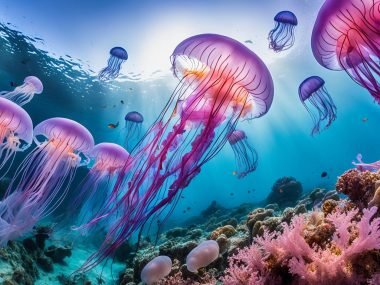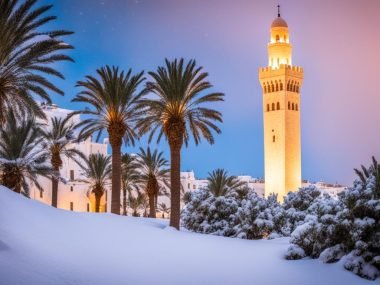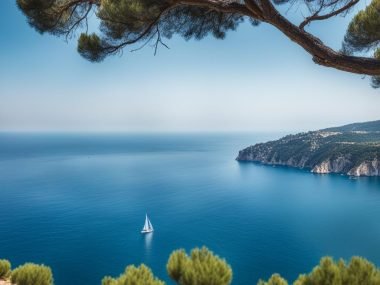Did you know Tunisia is the topmost country in Africa? It’s also one of the nearest parts of Africa to Europe. This makes Tunisia a key spot connecting Africa and Europe.
Tunisia, or al-Jumhūrīyah at-Tūnisīyah in Arabic, is rich in history and culture. It shares borders with Algeria, Libya, and the sea. It also has sea borders with Italy and Malta. Its capital, Tunis, is close to ancient Carthage, showing our long history since 814 BC.
Tunisia has diverse landscapes like fertile coasts, the Atlas Mountains, and the Sahara desert. This shows its unique spot in Africa. Ancient empires and modern history have shaped Tunisia. It shows our strong cultural identity and our role in Africa.
Key Takeaways
- Tunisia is the northernmost country in Africa, providing a strategic link between Africa and Europe.
- Officially known as the Republic of Tunisia, the nation boasts a rich cultural and historical tapestry.
- The capital city, Tunis, is near the ancient ruins of Carthage, reflecting Tunisia’s long historical timeline.
- Tunisia’s landscape ranges from the Mediterranean coastline and Atlas Mountains to the Sahara desert.
- Modern Tunisia has been influenced by various ancient realms, Arab conquests, and Ottoman rule.
The Location of Tunisia: North Africa
Tunisia is special because of where it is in North Africa. It’s the most northern country in Africa. Cape Angela is very close to Europe. This makes Tunisia very important in history and now.
Tunisia is big, with lots of different places inside. It has beautiful beaches and a big desert called the Sahara. These places make Tunisia very interesting.
In cities like Tunis and Sousse, old meets new. Here, you can see how Tunisia grows but still remembers its past.
Tunisia’s coast is important for trading. It connects Africa with Europe and other places. People in Tunisia have met many others because of this.
| Key Aspect | Details |
|---|---|
| Capital City | Tunis |
| Geographical Area | 163,610 square km |
| Northernmost Point | Cape Angela |
| Notable Cities | Tunis, Sfax, Sousse, Gabès |
| Continent | Africa |
In the end, Tunisia’s place in North Africa tells us a lot. It helps us see its history and today’s role. Knowing where Tunisia is helps us understand its big part in history and now.
Geographic Coordinates of Tunisia
Tunisia’s location is quite special on our planet. It sits at 34°N latitude and 9°E longitude. This mix brings together various climates and settings.
Tunisia’s Position in the World
Tunisia is where east meets west. It’s a mix of the Mediterranean and the Sahara Desert. This makes Tunisia a place of rich environmental variety.
Importance of Tunisia’s Geographic Coordinates
Tunisia’s coordinates are more than numbers. They help in navigation and in understanding climate changes. They’re key for trade and politics, too. They show how important Tunisia is globally.
| Aspect | Details |
|---|---|
| Latitude | 34°N |
| Longitude | 9°E |
| Regional Impact | Geopolitical strategy, environmental diversity |
| Maritime Boundaries | Italy, Malta |
Tunisia Continent: An Overview
Tunisia is in the African Continent Tunisia. It’s in the Maghreb region. This mix of African roots and Mediterranean vibes makes its culture very special.

Defining Tunisia’s Continental Placement
The Tunisian Geographic Location shows it’s in North Africa. This area is key to both ancient and modern history. The Tunisia Continent Name is African. Tunisia’s place has shaped many historical events.
This country has a history with the Carthaginian empire and Romans. Its past is rich and goes way back.
Historical Context of Tunisia on the African Continent
The 7th-century Arab invasions changed Tunisia a lot. They started an Arab-Muslim society. Then, the Ottomans added more to its culture and politics.
Tunisia has always been important globally. Many have left their mark here. This makes Tunisia’s African and Mediterranean sides stand out.
To summarise Tunisia’s position:
| Aspect | Details |
|---|---|
| Continent | Africa (North Africa) |
| Historical Significance | Carthaginian Empire, Roman Empire, Arab and Ottoman Influences |
| Region | Maghreb |
This tells us a lot about Tunisia in Africa. Its history and where it sits make its culture rich and always growing.
What Continent Is Tunisia In?
The simple answer to “What Continent Is Tunisia In?” is Africa. Tunisia is a key country in North Africa. It is very important geographically. Its place in Africa is shown by its African Union membership. This membership proves Tunisia’s close relationship with Africa.
Tunisia is in Africa but has many influences. Its culture and weather show ties to the Middle East and Europe. These links make Tunisia special in Africa and the Mediterranean area.
Let’s learn more about Tunisia’s place in the world:
| Aspect | Detail |
|---|---|
| Geographical location | Africa (North Africa) |
| Continental Association | African Union |
| Historical Connections | Middle East, Europe |
| Dominant Climate | Mediterranean |
| Cultural Influences | Arab, Berber, European |
Tunisia’s story is deeply rooted in the African continent. Its culture and strategic location make it a crossroads of culture.
Cultural and Ethnic Context of Tunisia
Tunisia’s culture mixes Arab-Berber heritage and influences from many civilisations. These have shaped the nation over centuries.
Arab-Berber Heritage
The Arab and Berber cultures combine to make Tunisia’s unique cultural identity. Tunisia’s original people, the Berbers, greatly influence its traditions. They impact the language, arts, and social ways.
Despite the larger Arab population, Berber traditions continue. They show how different backgrounds can come together peacefully.
Influences of Different Civilisations
Tunisia has welcomed many civilisations throughout time. The Phoenicians founded Carthage, and then came the Romans with their architecture. The Arabs introduced Islam in the 7th century.
The Ottomans and French later added their touches. They brought new ways of speaking, cooking, and ruling.
Tunisia’s culture shows in the languages spoken: Arabic officially and French for work and study. This makes Tunisia a colourful place with a rich, mixed identity.
Historical Background of Tunisia
Tunisia has a rich past, full of important times and cultures. Each one has left its mark. Let’s look at the big moments that made Tunisia what it is today.
Ancient Carthage
Ancient Carthage was started by the Phoenicians around the 9th century BC. It became a strong trade and military power. Its navy was huge and could reach far, even challenging Rome.

Roman and Arab Empires
After Carthage fell, the Romans made their mark in Tunisia. They built great buildings and brought Christianity. Then the Arabs came in the 7th century. Their arrival changed Tunisia’s culture and religion to Islam. They also brought Arab traditions.
Modern History and Independence
In 1956, Tunisia got its freedom from France. This started a new chapter. The country worked on its national identity. It grew with new social policies and economy changes. The 2011 Tunisian Revolution showed its dedication to democracy and change.
Tunisia’s Natural Landscapes: From the Mediterranean to the Sahara
Tunisia is home to amazing places, from beautiful beaches to the vast Sahara Desert. These places make Tunisia’s weather, farming, and holidays special. It’s a place of great beauty.
Mediterranean Coastline and Agriculture
The Mediterranean Coastline in Tunisia is over 1,300 kilometres long. It has fertile land that helps with farming. Olive farms are very important here.
The coast has pretty fishing villages and lively cities. They enjoy the sea activities and great weather.
Atlas Mountains
The Atlas Mountains in Tunisia are amazing to see. They help control the weather and have many plants and animals. Hiking here lets visitors see Tunisia’s nature and stunning views.
Sahara Desert
The Sahara Desert takes up much of southern Tunisia. It’s the biggest hot desert around. This place draws in those looking for adventure.
The desert has huge sand dunes and a unique look. It offers visitors a special Tunisian adventure.
Tunisia in the Maghreb Region
Tunisia is part of the Maghreb in North Africa. This area is known for similar history, culture, and languages. Tunisia joins Algeria, Libya, Morocco, and Mauritania in this group. They share a lot and influence each other greatly.
The Regional Location Tunisia in the Maghreb is very important. It shows Tunisia’s strong bonds with its neighbors. It also shows how they work together. They improve trade and help each other grow.
Tunisia is very involved in regional groups. This strengthens our ties to Maghreb North Africa. It helps everyone get along and support each other. Here are some important facts about Tunisia in the Maghreb:
| Attribute | Details |
|---|---|
| Geographical Placement | Located in North Africa, part of the Maghreb |
| Countries in Maghreb | Algeria, Libya, Morocco, Mauritania, Tunisia |
| Shared Interests | Socio-economic development, regional security, trade agreements |
| Economic Integration | Active participation in regional economic structures |
| Cultural Ties | Shared linguistic and cultural heritage |
Being part of the Maghreb means a lot to us. It’s not just where we are. It shows we care about working together for success and peace. Tunisia is key in the Maghreb. We help face challenges and use our strengths together.
Economic and Political Relations in Africa
Tunisia is an active member of the African Union. It focuses on regional cooperation and economic growth. Its location helps it work well with nearby African countries.
Regional Cooperation and Economic Ties
Tunisia has strong economic ties with other African countries. It has trade agreements with many nations, not just those nearby. These help trade and support growth for all involved. Tunisia is committed to working together for better economic development. This helps bring in investments, share knowledge, and build infrastructure.
Political Landscape and African Union Membership
Tunisia is a key member of the African Union. This membership helps it connect and solve problems with other countries. It works on keeping good relations, which helps on issues like security and growth. Tunisia wants to support a positive and cooperative Africa.
In short, Tunisia is dedicated to working with other African nations. Its role in the African Union helps it support growth and peace in Africa. Tunisia is keen on building stronger partnerships for the continent’s progress.







